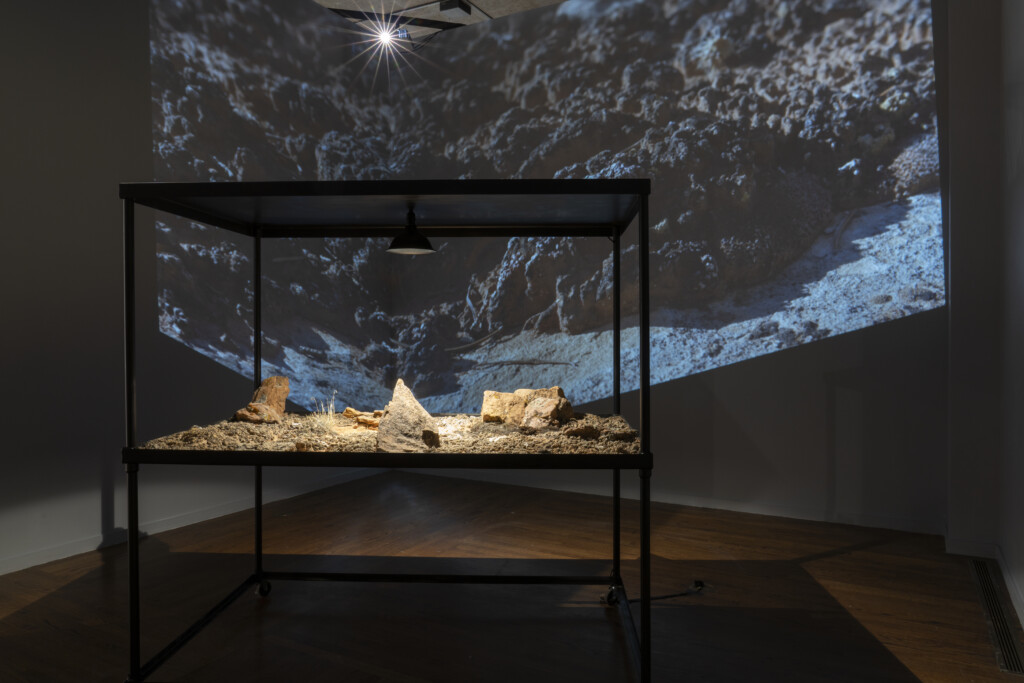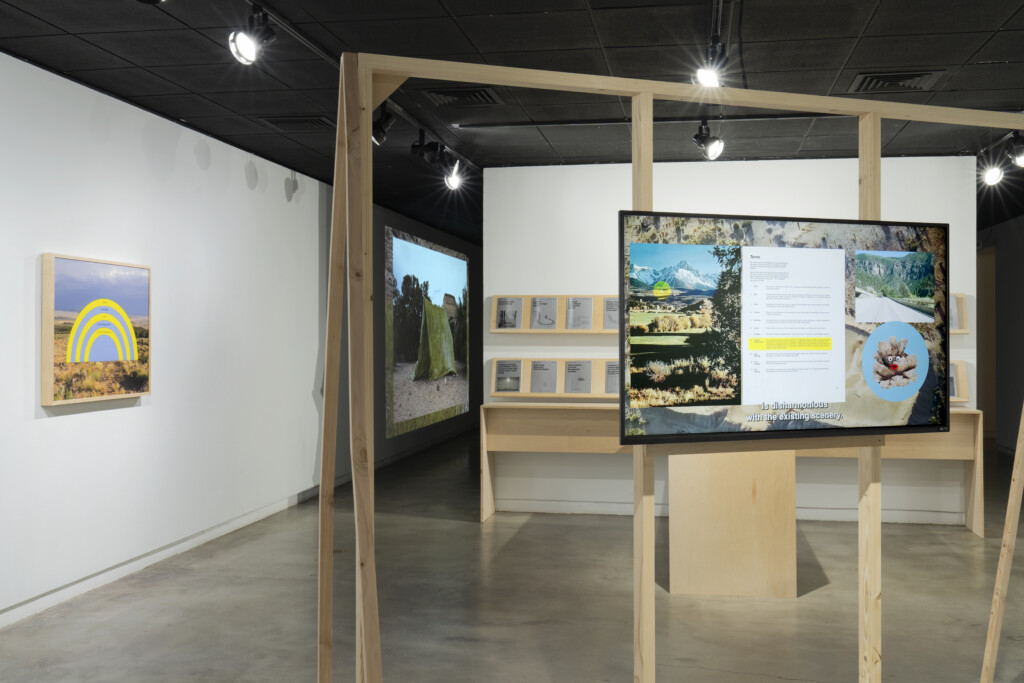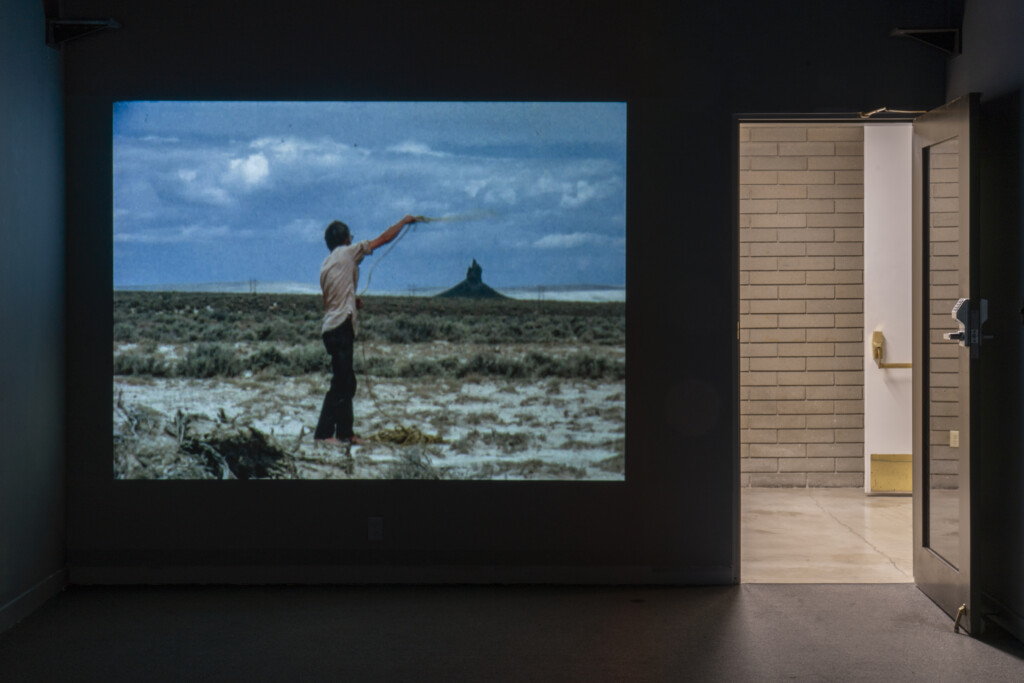With Earth Day approaching (April 22), an excellent representation of what is at stake in the Intermountain West’s natural surroundings is found in several exhibitions at the Utah Museum of Contemporary Art (UMOCA). The standout feature of these exhibitions is the extensive evidence of excellent cross-disciplinary approaches uniting science and the humanities. Among the areas of focus are the Great Salt Lake, the management of public lands and the biocrust.
AS THE LAKE FADES
In a recent social media post, Darren Parry, a local Shoshone Tribe leader, wrote, “Saving the Great Salt Lake is not a science problem, but a values problem.” This sentiment is evident, as the 15 artists in the exhibition As the Lake Fades (which continues through June 1) collectively build a compelling platform for sparking substantive cross-disciplinary conversations we should be having that connect scientists with their counterparts working in the humanities. The artwork girds the descriptive theme of the Great Salt Lake as our “nonhuman kinfolk,” which Parry recalled how his grandmother referred to it. While the exhibition is large in scope and presentation, its understated manner feeds a constructive, welcoming atmosphere that could help transcend partisan stubbornness, political identity and, hopefully, a good chunk of the recalcitrance we use in balking at our responsibilities as stewards of nature.
The historical perspective is represented in numerous examples. An 1883 oil painting Cliffs of Promontory Great Salt Lake (from the Church History Museum of The Church of Jesus Christ of Latter-Day Saints) by Alfred Lambourne is a textbook example of the grand works of art in the 19th century which romanticized the American West’s natural wonders. The lake’s portrayal evokes Lambourne’s description of it as Utah’s “inland sea” and the imagery stands out for its sense of vastness.

Its place in the exhibition is a benchmark that a viewer could compare to more contemporary representations in the show that highlight how the lake’s sense of vastness has shrunk dramatically. Likewise, an assortment of reproduced archival photographs from the Utah Historical Society and The University of Utah’s Marriott Digital Library collection capture images of the lake between 1880 and 1970, to provide other comparisons. A contemporary complement is the two-minute video Horizon (2023-2024), featuring filmmaker Eric Overton and writer and poet Terry Tempest Williams. It ties the imperative of the lake’s legacy with the representation of the ecosystem documented by the exhibition’s other artists.
Sant Khalsa’s Western Waters (2000-2002) highlights the contemporary consumer obsession with buying water in plastic bottles because of fears that tap water is not purified. Her display comprises 60 photographs of stores in Arizona, New Mexico and the southern regions of California and Nevada, which advertise the availability of reverse-osmosis purified water. Khalsa’s photographic documentation has historical value, especially as a growing number of consumers have realized that the plastic bottles are not readily biodegradable and are turning to reusable water bottles, filtration systems and compostable packaging.
Directly across from Lambourne’s painting, there is Tom Judd’s SALTAIR, a 2023 work of mixed media on canvas tarp. Judd reproduces an archival image of the famous Saltair Resort on the lake’s southern shore. However, the image is dulled, tattered and frayed, indicating that even memories might not be strong enough to energize our resolve to step up as responsible stewards of the lake.

Two video installations make for outstanding companion pieces, linking the lake’s natural historical legacy to its existential threats. Alisha Anderson’s lacustrine (2016) is an exceptional example of documentary art as video poetry, which ingeniously weaves in the stakes, as the nine-minute film’s title suggests. A term from geological science, lacustrine refers to a dried lake plain that forms from what once was a lake, along with its sediments.
The point is reinforced with Anne-Katrin Spiess’ 2022 Great Toxic Lake video, which runs just barely two and a half minutes. Spiess filmed the piece when the lake was at its lowest level two years ago and with news that toxic levels of arsenic, copper and mercury from a dried lakebed could find their way into the air, putting Wasatch Front residents at risk for potentially severe health complications. Anderson’s video emphasizes natural beauty and pinpoints the stakes with poetic nuance while Spiess’ video is starker and plainspoken about the consequences.
This point is reinforced with Kaitlyn Bryson’s may we decompose violence in ourselves before we ask it of the world (2024). The exquisite artistry of the natural-dyed quilted textile, which spans seven feet, belies its scientific provenance. She depicts arsenic’s spectrum of light signature on the textile, which has been inoculated with two species of fungi known for facilitating the transformation of and sequestering of arsenic in their biomass. Her work illustrates the beneficial value of bioremediation.

Bryson’s skillful cross-fertilization of disciplinary elements from science and humanities make for one of the exhibition’s finest pieces. Adding another layer to the promises of bioremediation, Bryson embroidered text from Brontë Velez of the Weaving Earth Center for Relational Education. She also consulted Kalyn Mae Finnell about the biochemistry of natural dyes and Danielle Stevenson on her work in bioremediation and ecotoxicology. As the quilt ages, which she explained in her artistic statement, “the representation of arsenic’s light signature is visually altered by the growth/consumption of the fungi, making visible a contemporary alchemical ritual of transformation and healing.”
An equally outstanding example of the cross-disciplinary presentation is Andrew S. Yang’s 2023 diptych, printed on vinyl. One piece is A Record of Heedless History, which chronicles the planet’s variations in summer temperature since 1880, while the other is A Space of Pivotal Possibility, which projects temperature variations for the next 145 years. Yang incorporated data from NASA Goddard Institutes for Space Studies and graphs from the NASA Earth Observatory, courtesy of Lauren Dauphin.
The historical piece is rendered in color bands to mark the temperature variations while the second piece is left in gray tones to convey that the models do not necessarily have to fulfill estimated probabilities. Yang’s presentation is effective because it highlights the critical value of human agency in responding to climate-based challenges, in the hopes of avoiding the most dire consequences.
Two pieces by Michael Handley — To Die Unsung (2021) and A Funnel Is Not a Cone (2022) — also highlight pigments. Reflecting on the scars of wildfires in forest areas where he had hiked, the artist, a southern Utah native, uses fire retardants suspended in pigment to create To Die Unsung on paper. It captures what the forest looked like in the past and now shows the first sign of rebirth in the flora after a wildfire.
In the second piece, the sculpture A Funnel Is Not a Cone, Handley submerged a pair of boots in water with pigment and as they dry, the pigments intensify in color — a representation of the effects of drier landscapes in the Intermountain West. Meanwhile, Mary Toscano’s four pieces on paper (2022) — drawn superbly in pencil with meticulous detail — resemble pages from an archaeological diary. Her drawings document miscellaneous objects which could be discovered and exposed, if the lake’s water and shoreline continue to recede.
Likewise, Fritz Kollman, a landscaper and horticulturist, takes up the cross-disciplinary relay baton, in Sedges (2024), a work that cues alternative ways to conserving water through native plants and gardens. Kollman turns the light on Western Meadow Sage. “From flowery, shrub-dotted meadows to restored mountain maple and Gambel oak forests, there are nearly limitless options for ecologically sound, water saving design,” Kollman, who was lead horticulturist at Red Butte Gardens and the garden supervisor at Las Vegas’ Springs Reserve, noted. “Focusing the design of new landscapes and gardens can cultivate an aesthetic return to the ecotones that have historically nurtured life in northern Utah. By refamiliarizing ourselves with native plants and habitats, and shifting gardening and landscape practices, we acknowledge the crucial role our actions play in maintaining the space we inhabit.”

DIANE TUFT: ENTROPY
Just as prominent in its cross-disciplinary approach as the artists engage with in As The Lake Fades, photographer Diane Tuft’s Entropy (open through April 27) is stunning for its vivid colors but also alarming for its documentation of the climate-related stresses on the Great Salt Lake. The artwork documents the impacts through saturated colors, visible cracks, and clear textures.
These photographs are from 2022 and viewers should keep in mind that these images are magnified in their significance once they also have seen the video pieces — notably Anderson’s lacustrine and Spiess’ Great Toxic Lake — in the As The Lake Fades exhibition. Entropy reinforces the consensus that both scientists and their creative counterparts in arts and humanities have cultivated about the dire state of the Great Salt Lake.

JORGE ROJAS AND SASHA REED: THE BIOCRUST PROJECT
Yet another outstanding example of cross-disciplinary expression is The Biocrust Project by Jorge Rojas and Dr. Sasha Reed (open through through June 1, 2024). As the inaugural Canyonlands Research Center’s Artist in Residency project, courtesy of The Nature Conservancy, Rojas and Reed offer an immersive audiovisual installation and a centerpiece — a beautifully constructed scene of the biocrust, commonly referred to as the desert’s skin.
Rojas, a Utah multidisciplinary artist whose work is internationally recognized, is the center’s first artist in residence. He connected to Reed, a U.S. Geological Survey researcher, who has been studying the biological significance of the biocrust and has been augmenting her work with contributions from Indigenous knowledge.

photo by Zachary Norman, © UMOCA
The CRC program, based at the Dugout Ranch near Moab (which The Nature Conservancy owns), is dedicated to cross-disciplinary perspectives joining artists and scientists. In a 2023 interview with the Moab Sun News, Rojas explained, “When people think about sustainability, people usually think about the Amazon, or glaciers.” He added, “But [biocrust] is the living skin of the Earth.”
Reed, who also was interviewed for the article, explained that the biocrust actually plays a larger role in how drylands absorb carbon dioxide, thereby reversing previous conceptualization of deserts as “lifeless wastelands.” As for collaborating with Rojas, “Art and science are two sides of the same coin,” Reed told the Moab Sun News. “Both are about communicating things about the world to each other.”

EVERYTHING IS COLLECTIVE: EXPECTED IMAGE
Very rarely in news about the Bureau of Land Management (BLM) and public lands policies is a mention of the Visual Resource Management (VRM) system. In Everything Is Collective: Expected Image, (open through April 27), Everything Is Collective offers a compact yet engrossing look at how the VRM, which has been used for nearly 50 years, conceives natural spaces and landscapes within the parameters of an “expected image.” That is, “an expected image is a mental picture of what a person expects to see in a natural landscape; it implies a feedback loop between art and culture.” With videos, prints and other materials, the exhibition functions as a primer, to provoke discussions on a broader epistemological spectrum about our understanding of policy making for nature conservation and preservation and the influence of that process upon what values drive these broader objectives.
Of note is the two-channel video installation, Visual Landscapes, in which the first channel features an accurate and realistic CGI depiction of a Western U,S, landscape while the second channel features footage taken from a video camera of the terrain, including audio by Justin Houser and Seth Warren-Crow. The installation emphasizes the significance of how the measure of visual resource, as the VRM has operationally defined, can have major consequences in land use policy.
In a federal policy paper from the mid-1970s, the text opened with the following:
It’s been said that in America there is more space where nobody is than where anybody is …, and that’s what makes America what it is. Perhaps there is no place that statement is more true than in the great, open space of the western United States and Alaska. We, of course, still think of this as America’s own land of opportunity, adven-ture, intrigue, mystique, and enchantment.
The history of federally-owned or controlled lands is indeed a chronicle of our Nation and her people; of their struggles, failures, and successes. It also provides a perspective of our own sensitivity to the land and its resources, as a provider for present and future generations.

Most fascinating in this exhibition is how the foundational visual elements of art and aesthetics (form, line, color and texture) have been transformed in the VRM from subjective considerations to consistently applied definable metrics which then are scored quantitatively. Boiling it down to simplest terms, the BLM notes, “The stronger the influences exerted by these elements, the more interesting the landscape. The more visual variety in a landscape, the more aesthetically pleasing that landscape. Variety without harmony, however, is unattractive, particularly in terms of man-made alterations (cultural modifications) that are made without care.”
Everything is Collective’s absorbing presentation opens the discussion to potential flaws and weaknesses in an institutionalized meticulous bureaucratic analytical protocol. For example, how do measures of scenic quality matter, for example, to the logging industry and hunters or those tourists who visit the lands for recreation or for those who reside in natural settings. Also, visual resources have been seen generally as a subset of recreation, when it comes to budget appropriations. Returning to the forest example, how can we then ensure that a visual resource would be considered equal to its recreational value as well as those of other primary sources.

PAUL KOS: ORACLES
Continuing a string of impressive video art pieces from internationally known artists in UMOCA’s Codec Gallery, Paul Kos: Oracles (available through June 29) comprises a series of short video art pieces, most of which date to the 1970s. Kos, a Wyoming native, is one of the contemporary age’s best known conceptual artists. Now in his eighties, Kos was a pioneer in the Bay Area conceptual art movement, which expanded channels for performance, media and installation art,with minimalism so as not to divert attention from the philosophy being expressed in the work.
The Oracles videos reflect an unmistakable Buddhist minimalistic aesthetic. Among the highlights is Warlock(ing), a black-and-white video from 1971, where Kos has set up traps for small game but instead uses them to catch raindrops. The video runs seven and a half minutes and the viewer could be easily absorbed in watching when the traps finally catch the rain. In Ice Makes Fire (1974 and restaged in 2004), the artist turns a chunk of ice into a magnifying lens which ignites a fire in a small pile of branches in the snow.
An absurdist reflection on the occasional shortcomings of language’s descriptive power, Riley, Roily, River (1975) depicts the rush of water in a river while the voiceover descends into a shouting match about whether the river should be described as “riley” or “roily.” Kos offers his own variation on the line “if a tree falls in the forest…” with Lightning (1976), a short of less than 90 seconds which was filmed inside a car. Kos riffs off the sirens from The Odyssey in a six-and-a-half-minute short, with four mini surrealistic tableaux that combine into a trance vibe. Meanwhile, a projection on the gallery’s opposite wall loops continuously Kos’ Roping the Boar’s Tusk, a 1971 short originally filmed in Super 8.
In a 2012 interview with The Brooklyn Rail, Kos explained his work, “I try to work under some of the following self-imposed precepts: reveal slowly; prove metaphor is more; heed site or be shortsighted; respect simple humble materials; prefer art that is, to art that is about; strive for equilibrium in message and messenger; and finally, opt for, but never expect, ‘partly cloudy, becoming mostly sunny.’” Indeed, all of these Kos shorts demonstrate how the artist consistently applied these precepts.
For more information about the exhibitions and other museum programming, see the UMOCA website.

